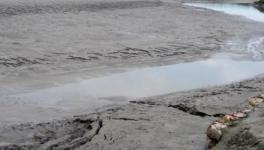Bihar: Flood-Hit People Forced to Take Shelter on Embankments, National Highways
Patna: After floods inundated their villages, thousands of people, including women, children and the elderly, in the worst-affected West and East Champaran districts of Bihar, have been forced to take shelter on nearby high-rise embankments and national highways.
As flood waters submerged large tracts of lands and marooned more than 250 villages in both the districts, most of the displaced people have erected temporary covers over their heads with black polythene sheets.
“The government has failed to provide us with anything so far. There is no light (power), no food and no toilets. We are living in the dark at night, facing danger from poisonous snakes. All of us have taken shelter on the Champaran embankment along Gandak river,” said Irshad Ansari ,a resident of Dhekaha village under Kesaria block.
Ansari and his family of seven members has been struggling to manage life without basic food items. “What can we do except look for help and relief,” he said.
Bhola Prasad, who has also erected a temporary shelter with black polythene sheets, hardly five feet away from Ansari’s, said life was full of misery. “Our village was marooned by the flood waters. We have been on embankments since the past seven days. There is no arrangement of food, children have been crying of hunger. Relief is yet to reach us”, he said, adding that local administration had “hardly bothered to provide us with food items to survive.”
Both Ansari and Prasad are also worried over lack of green feed for their cattles, including cows and goats.
Amar, a Mehsi-based social activist in Champaran, said village after village was marooned by flood waters from all sides. Most people are displaced and some are stranded in villages “The long stretch of river embankment is full of people displaced by flood waters,” he added.
Hamid Raza, a local activist said people from over two dozen villages, including Bairiya, Dhekaha, Manjhatiya and Sundarpur, have taken shelter on embankments. “For them, survival is a big challenge. There is no relief from the government’s side. However, some local people have come forward to help them”, he said.
Flood-affected people from dozens of villages under Sugauli block, too, have taken shelter on a national highway, As per reports reaching here, flood waters have entered most of the villages in the block and people there have been waiting for relief.
The flood situation in East and West Champaran has worsened in the past 24 hours following heavy rainfall since last week in the catchment areas of Himalayan rivers in neighbouring Nepal and in Bihar. The water level has risen in Gandaka and Burhi rivers and their tributaries, marooning hundreds of villages in low-lying areas. The other rivers, including Bagmati, Koshi, Kamla Balan, Bhutahi Balan and Ghaghra, are also in spate due to heavy rains. The water level in the Ganga is rising in Patna and Bhagalpur districts.
The rising Gandak has wreaked havoc in large areas as flood waters have also cut off villages by snapping roads, washing away small bridges and threatening to damage embankments. The Bihar Water Resources Department says the Gandak was flowing above the danger mark in a few places.
With water levels rising in other rivers as well, the state government has alerted district magistrates of at least a dozen districts, including Gopalganj, Muzaffarpur, Siwan, Saran and Madhubani of the possibility of a flood-like situation. Keeping this in view, over a dozen teams of the National Disaster Response Force (NDRF) and the State Disaster Response Force (SDRF) have been deployed in vulnerable areas.
Ranjeev, an environment activist, said the more than normal rains soon after the monsoon entered Bihar is an example of climate change. “It is not merely a surplus of rain, it is much more than that as the state received 176% excess rainfall in 20 days of June, as per data released by the local weather office. More rains are expected in the next 24 hours and in the coming days. This is a warning sign that the climate has been changing. This year, the summer almost passed without a heat wave in the state”, he said.
However, the water resources department has said that all embankments were safe and there was no need to panic.
Meanwhile, the pressure on river embankments had increased after the discharge of a record amount of water into the river. Authorities in flood-prone districts have asked people living in vulnerable and low-lying areas to shift to safer places. The state government has asked engineers and district officials to keep a round-the-clock vigil.
Last year, Bihar received surplus rains due to ‘more than norma’l monsoon that entered the state at the right time. According to India Meteorological Department’s annual rainfall report, Bihar receives 1,027.6 mm rainfall in a normal monsoon year; the average annual rainfall through the year in all seasons is 1,205.6 mm.
According to the water resource department’s website, Bihar is the most flood-affected state, accounting for close to 17.2% of the total flood-prone area in the country. Out of 94.16 lakh hectare area, 68.80 lakh ha (76% of North Bihar and 73% of South Bihar) is flood-prone. At present, 28 out of 38 districts in the state are flood-prone.
Get the latest reports & analysis with people's perspective on Protests, movements & deep analytical videos, discussions of the current affairs in your Telegram app. Subscribe to NewsClick's Telegram channel & get Real-Time updates on stories, as they get published on our website.
























